When I run my app, OpenGL Driver Monitor says the Textures count is rapidly increasing — within 30 seconds the Textures count increases by about 45,000.
But I haven't been able to find the leak. I've instrumented every glGen*() call to print out every GL object name it returns — but they're all less than 50, so apparently GL objects created by glGen*() aren't being leaked.
It's a large, complex app that renders multiple shaders to multiple FBOs on shared contexts on separate threads, so reducing this to a simple test case isn't practical.
What else, besides glGen*() calls, should I check in order to identify what is leaking?
